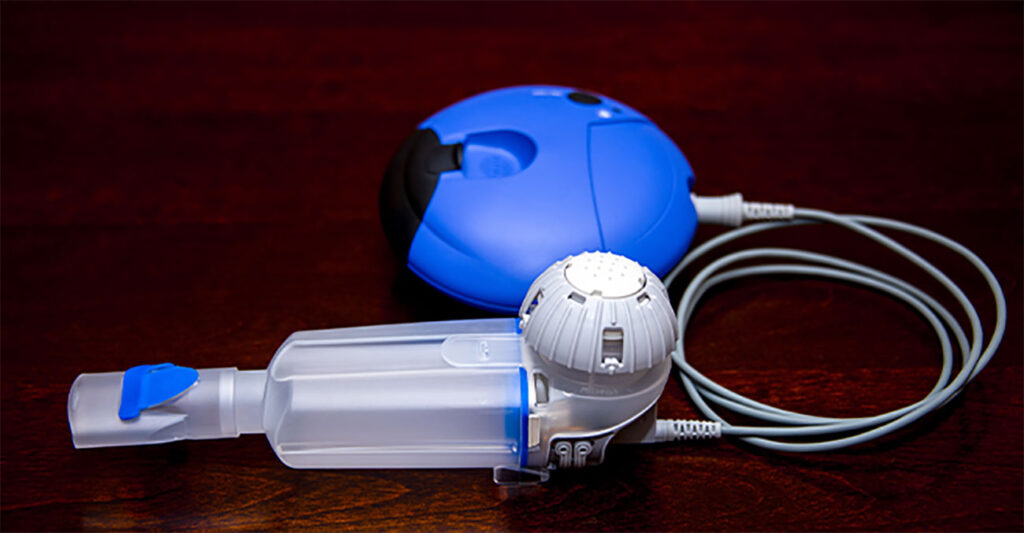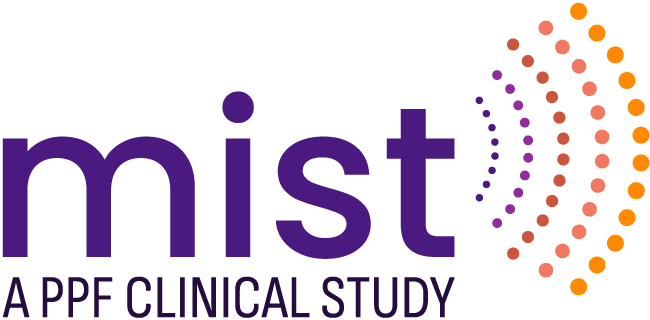| Program | IND | Phase 1 | Phase 2 | Phase 3 |
|---|---|---|---|---|
AP01 (Inhaled Pirfenidone) | ||||
 Now recruiting – visit the MIST Study website Pirfenidone is a small molecule inhibitor that attenuates profibrotic pathways, including TGF-β1, which is implicated in fibroblast differentiation and ECM production. In its oral formulation, however, pirfenidone is a low-potency drug that requires a very large dose to deliver sufficient levels to the lung. These doses are associated with adverse events, including GI pain, diarrhea, dyspepsia, photosensitivity, rash, fatigue, and elevated liver enzymes, which can lead to liver damage. Due to these systemic toxicities, prescribing is limited, and compliance is often poor, reducing the product’s potential benefit.  Avalyn has reformulated pirfenidone for inhaled aerosol lung delivery via an approved handheld eFlow® vibrating membrane nebulizer. This aerosolized formulation allows small inhaled doses to be delivered as a soft mist directly to the lung, maximizing pirfenidone’s lung dose and effect on diseased lung tissue while sparing tissue outside the lungs from oral-associated drug levels. Phase 1b ATLAS Study (n=91) complete: 91 participants with Idiopathic Pulmonary Fibrosis were administered one of two doses of AP01 (50 mg once daily and 100 mg twice daily). Results in brief: AP01 was dose-responsive, wherein the 100 mg BID dose achieved near-stabilization of lung function, on average, over 48 weeks of treatment. AP01 was well tolerated with fewer systemic adverse events vs. historic oral pirfenidone. Adverse events were generally mild, with mild cough being the most common. A fully-enrolled open label study is on-going wherein the first enrolled participants have been on therapy for greater than four years. | ||||
AP02 (Inhaled Nintedanib) | ||||
|
Nintedanib is a small molecule inhibitor of multiple tyrosine kinases, interrupting the cellular processes that lead to lung fibrosis, thus slowing the progression of pulmonary fibrosis. Unfortunately, oral nintedanib treatment is associated with adverse events attributable to its systemic delivery. These include diarrhea, hyperbilirubinemia (increased serum bilirubin, which can lead to jaundice), and drug-induced liver injury. Avalyn has reformulated nintedanib for inhaled aerosol lung delivery. In animal models, an oral-superior, dose-dependent reduction in fibrosis was accomplished using inhaled dose levels up to 1/75th the human oral dose. Phase 1a study complete (n=38): 38 healthy volunteers and participants with IPF were administered a single nebulized dose of either 0.5 mg, 1 mg or 2 mg AP02 or placebo and monitored for safety, tolerability and pharmacokinetics. Results to be presented at upcoming scientific conference. | ||||
AP03 (Inhaled Fixed-Dose Combination of Pirfenidone & Nintedanib) | ||||
|
The combination of pirfenidone and nintedanib can offer patients significant efficacy advantages over either product alone. A combination of oral medications has not been feasible due to their additive side effect profiles. AP03 is a fixed-dose combination that we intend to develop for inhaled delivery. Our data indicate that as stand-alone therapies, Avalyn’s product candidates may substantially reduce or eliminate the adverse effects of oral pirfenidone and oral nintedanib. Further, direct drug delivery to the lungs may increase their efficacy by delivering an optimized dose. Moreover, as safe and well-tolerated medicines, inhalation may improve compliance and enable use in otherwise poorly tolerated add-on combination regimens. | ||||
AP0X (Undisclosed) | ||||
| Program | IND | Phase 1 | Phase 2 | Phase 3 |
|---|---|---|---|---|
| (AP01) Inhaled Pirfenidone | ||||
 Now recruiting – visit the MIST Study website Pirfenidone is a small molecule inhibitor that attenuates profibrotic pathways, including TGF-β1, which is implicated in fibroblast differentiation and ECM production. In its oral formulation, however, pirfenidone is a low-potency drug that requires a very large dose to deliver sufficient levels to the lung. These doses are associated with adverse events, including GI pain, diarrhea, dyspepsia, photosensitivity, rash, fatigue, and elevated liver enzymes, which can lead to liver damage. Due to these systemic toxicities, prescribing is limited, and compliance is often poor, reducing the product’s potential benefit.  Avalyn has reformulated pirfenidone for inhaled aerosol lung delivery via an approved handheld eFlow® vibrating membrane nebulizer. This aerosolized formulation allows small inhaled doses to be delivered as a soft mist directly to the lung, maximizing pirfenidone’s lung dose and effect on diseased lung tissue while sparing tissue outside the lungs from oral-associated drug levels. Phase 1b ATLAS Study (n=91) complete: 91 participants with Idiopathic Pulmonary Fibrosis were administered one of two doses of AP01 (50 mg once daily and 100 mg twice daily). Results in brief: AP01 was dose-responsive, wherein the 100 mg BID dose achieved near-stabilization of lung function, on average, over 48 weeks of treatment. AP01 was well tolerated with fewer systemic adverse events vs. historic oral pirfenidone. Adverse events were generally mild, with mild cough being the most common. A fully-enrolled open label study is on-going wherein the first enrolled participants have been on therapy for greater than four years. | ||||
| (AP02) Inhaled Nintedanib | ||||
|
Nintedanib is a small molecule inhibitor of multiple tyrosine kinases, interrupting the cellular processes that lead to lung fibrosis, thus slowing the progression of pulmonary fibrosis. Unfortunately, oral nintedanib treatment is associated with adverse events attributable to its systemic delivery. These include diarrhea, hyperbilirubinemia (increased serum bilirubin, which can lead to jaundice), and drug-induced liver injury. Avalyn has reformulated nintedanib for inhaled aerosol lung delivery. In animal models, an oral-superior, dose-dependent reduction in fibrosis was accomplished using inhaled dose levels up to 1/75th the human oral dose. Phase 1a study complete (n=38): 38 healthy volunteers and participants with IPF were administered a single nebulized dose of either 0.5 mg, 1 mg or 2 mg AP02 or placebo and monitored for safety, tolerability and pharmacokinetics. Results to be presented at upcoming scientific conference. | ||||
| (AP03) Inhaled Fixed-Dose Combination of Pirfenidone & Nintedanib | ||||
|
The combination of pirfenidone and nintedanib can offer patients significant efficacy advantages over either product alone. A combination of oral medications has not been feasible due to their additive side effect profiles. AP03 is a fixed-dose combination that we intend to develop for inhaled delivery. Our data indicate that as stand-alone therapies, Avalyn’s product candidates may substantially reduce or eliminate the adverse effects of oral pirfenidone and oral nintedanib. Further, direct drug delivery to the lungs may increase their efficacy by delivering an optimized dose. Moreover, as safe and well-tolerated medicines, inhalation may improve compliance and enable use in otherwise poorly tolerated add-on combination regimens. | ||||
| (AP0X) Undisclosed | ||||


